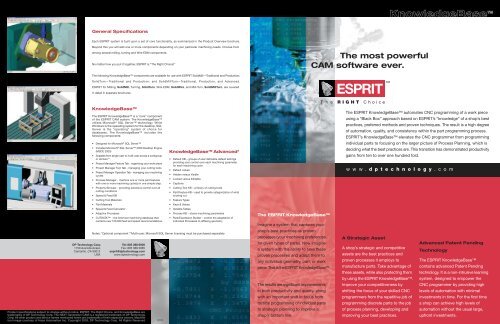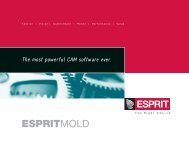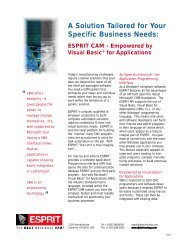ESPRIT KnowledgeBase - Chicago CAD CAM Software
ESPRIT KnowledgeBase - Chicago CAD CAM Software
ESPRIT KnowledgeBase - Chicago CAD CAM Software
Create successful ePaper yourself
Turn your PDF publications into a flip-book with our unique Google optimized e-Paper software.
DP Technology Corp.<br />
1150 Avenida Acaso<br />
Camarillo, CA 93012<br />
USA<br />
General Specifications<br />
Each <strong>ESPRIT</strong> system is built upon a set of core functionality, as summarized in the Product Overview brochure.<br />
Beyond this you will add one or more components depending on your particular machining needs. Choose from<br />
among several milling, turning and Wire EDM components.<br />
No matter how you put it together, <strong>ESPRIT</strong> is “The Right Choice!”<br />
The following <strong>KnowledgeBase</strong> components are available for use with <strong>ESPRIT</strong> SolidMill—Traditional and Production;<br />
SolidTurn—Traditional and Production; and SolidMillTurn—Traditional, Production, and Advanced.<br />
<strong>ESPRIT</strong> for Milling, SolidMill, Turning, SolidTurn, Wire EDM, SolidWire, and Mill-Turn, SolidMillTurn, are covered<br />
in detail in separate brochures.<br />
<strong>KnowledgeBase</strong><br />
The <strong>ESPRIT</strong> <strong>KnowledgeBase</strong> is a “core” component<br />
of the <strong>ESPRIT</strong> <strong>CAM</strong> system. The <strong>KnowledgeBase</strong><br />
utilizes Microsoft ® SQL Server technology. While<br />
Windows is the operating system for the desktop, SQL<br />
Server is the “operating” system of choice for<br />
databases. The <strong>KnowledgeBase</strong> includes the<br />
following components:<br />
• Designed for Microsoft ® SQL Server<br />
• Includes Microsoft ® SQL Server 2000 Desktop Engine<br />
(MSDE 2000)<br />
• Scalable from single-user to multi-user across a workgroup<br />
or domain**<br />
• Project Manager Feature Tab - organizing your work piece<br />
• Project Manager Tool Tab - managing your cutting tools<br />
• Project Manager Operation Tab - managing your machining<br />
cycles<br />
• Process Manager - machine one or more part features<br />
with one or more machining cycle(s) in one simple step.<br />
• Property Browser - providing extensive control over all<br />
cutting conditions<br />
• Speed & Feed KB<br />
• Cutting Tool Materials<br />
• Part Materials<br />
• Speed & Feed Calculator<br />
• Adaptive Processes<br />
• CUTDATA* - the foremost machining database that<br />
contains over 100,000 feed and speed recommendations.<br />
Tel: 805 388 6000<br />
Fax: 805 388 3085<br />
esprit@dptechnology.com<br />
www.dptechnology.com<br />
Product specifications subject to change without notice. <strong>ESPRIT</strong>, The Right Choice, and <strong>KnowledgeBase</strong> are<br />
trademarks of DP Technology Corp. The NEXT Generation <strong>CAM</strong> is a registered trademark of DP Technology<br />
Corp. All other product and service names mentioned herein are trademarks of their respective owners. Machine<br />
tool image courtesy of Haas Automation Inc. Copyright 2003, DP Technology Corp. All Rights Reserved.<br />
0403 1000 0503<br />
<strong>KnowledgeBase</strong> Advanced*<br />
• Default KB – groups of user definable default settings<br />
providing user control over each machining parameter<br />
for each machining cycle.<br />
• Default values<br />
• Hidden versus Visible<br />
• Locked versus Editable<br />
• Captions<br />
• Cutting Tool KB – a library of cutting tools<br />
• Part/Feature KB – used to provide categorization of what<br />
is being cut<br />
• Feature Types<br />
• Keys & Values<br />
• Variable Tables<br />
• Process KB – stores machining parameters<br />
• Rule/Expression Builder - control the adaptation of<br />
individual Processes to differing geometry<br />
Notes: *Optional component **Multi-user: Microsoft SQL Server licensing must be purchased separately<br />
The <strong>ESPRIT</strong> <strong>KnowledgeBase</strong><br />
Imagine a system that captures your<br />
shop’s best practices as proven<br />
processes (your machining preferences<br />
for given types of parts). Now imagine<br />
a system with the ability to take these<br />
proven processes and adapt them to<br />
any individual geometry, part, or work<br />
piece. That is the <strong>ESPRIT</strong> <strong>KnowledgeBase</strong>.<br />
The results are significant improvements<br />
in both productivity and quality, along<br />
with an important shift in focus from<br />
tactical programming of individual parts<br />
to strategic planning to improve a<br />
shop’s bottom line.<br />
The most powerful<br />
<strong>CAM</strong> software ever.<br />
<strong>ESPRIT</strong><br />
T h e RIGHT Choice<br />
A Strategic Asset<br />
A shop’s strategic and competitive<br />
assets are the best practices and<br />
proven processes it employs to<br />
manufacture parts. Take advantage of<br />
these assets, while also protecting them<br />
by using the <strong>ESPRIT</strong> <strong>KnowledgeBase</strong>.<br />
Improve your competitiveness by<br />
shifting the focus of your skilled CNC<br />
programmers from the repetitive job of<br />
programming discrete parts to the job<br />
of process planning, developing and<br />
improving your best practices.<br />
<strong>KnowledgeBase</strong> <br />
The <strong>ESPRIT</strong> <strong>KnowledgeBase</strong> automates CNC programming of a work piece<br />
using a “Black Box” approach based on <strong>ESPRIT</strong>’s “knowledge” of a shop’s best<br />
practices, preferred methods and proven techniques. The result is a high degree<br />
of automation, quality, and consistency within the part programming process.<br />
<strong>ESPRIT</strong>’s <strong>KnowledgeBase</strong> elevates the CNC programmer from programming<br />
individual parts to focusing on the larger picture of Process Planning, which is<br />
deciding what the best practices are. This transition has demonstrated productivity<br />
gains from ten to over one hundred fold.<br />
w w w . d p t e c h n o l o g y . c o m<br />
Advanced Patent Pending<br />
Technology<br />
The <strong>ESPRIT</strong> <strong>KnowledgeBase</strong><br />
contains advanced Patent Pending<br />
technology. It is a non-intrusive learning<br />
system, designed to empower the<br />
CNC programmer by providing high<br />
levels of automation with minimal<br />
investments in time. For the first time<br />
a shop can achieve high levels of<br />
automation without the usual large,<br />
upfront investments.
Process Planning<br />
Using <strong>ESPRIT</strong>, a CNC programmer<br />
decides how a given part/feature is<br />
machined by specifying the machining<br />
cycles, cutting tools, and machining<br />
parameters needed to create the<br />
tool path to machine the part.<br />
The <strong>KnowledgeBase</strong> provides a<br />
mechanism to manage these<br />
Processes by providing answers to<br />
questions like: What is the best known<br />
method to machine a given part?<br />
How were similar parts machined<br />
previously and what could be done<br />
to improve those processes?<br />
Each time a process in the<br />
<strong>KnowledgeBase</strong> is used to program<br />
a part it is refined in a continuous<br />
circular method, by retrieving what<br />
works and improving upon it.<br />
Closing the Loop<br />
Adaptive <strong>CAM</strong> <strong>Software</strong><br />
When a <strong>KnowledgeBase</strong> machining<br />
Process is applied to an individual<br />
part it will adapt to the given geometry,<br />
selecting the specific process steps<br />
(machining cycles), cutting tools, and<br />
machining parameters to be used. The<br />
programmer does not need to rely on<br />
his memory to recall what worked last<br />
time; this information is known by the<br />
<strong>KnowledgeBase</strong>. A shop’s best<br />
practices are always readily available<br />
for any CNC programmer to use.<br />
While associative systems are capable<br />
of updating tool path based on<br />
revisions to geometry within a given<br />
part, <strong>ESPRIT</strong>’s Adaptive system<br />
extends this concept across part<br />
families and even to similar features<br />
of completely unrelated parts. More<br />
importantly, an adaptive system stores<br />
the processes independently of the<br />
part geometry and will update cutting<br />
tools, machining cycles, and<br />
machining parameters as necessary<br />
to accommodate any given geometry.<br />
The multi-user database built into <strong>ESPRIT</strong>’s <strong>KnowledgeBase</strong> closes the<br />
loop between CNC programming and the shop floor by providing a central<br />
repository to accumulate your experiences. What works (your best practices)<br />
will be refined using real world input from the shop floor. By using the<br />
<strong>KnowledgeBase</strong> your parts will be produced in a more consistent fashion,<br />
regardless of who programs the job or which CNC machine tool they are run<br />
on. As ideas for improvements arise, the Processes are updated for the<br />
benefit of the current and all future jobs. You will have a new level of uniformity<br />
between CNC programmers, operators and machines. Similar parts are<br />
programmed and machined with undeviating consistency providing more<br />
predictable, accurate results and greater profits.<br />
Adaptive Processes<br />
As an example let’s specify a couple<br />
of rules for machining slots: the cutting<br />
tool must be 75% of the slot width,<br />
and the depth of cut must not exceed<br />
100% of the tool diameter. In this case<br />
a change to the part geometry, width<br />
of the slot, will result in the process<br />
adapting by selecting a different<br />
cutting tool, and changing cutting<br />
depths and possibly other machining<br />
parameters. Adding a chamfer to an<br />
existing hole, or changing the corner<br />
radius in a pocket will require similar<br />
changes in the selection of the<br />
process itself, machining cycles,<br />
cutting tools, and machining<br />
parameters. The adaptive capabilities<br />
of the <strong>ESPRIT</strong> <strong>KnowledgeBase</strong><br />
system will handle these real-world,<br />
industrial challenges.<br />
Feature Based Machining<br />
<strong>ESPRIT</strong>’s <strong>KnowledgeBase</strong> Automated Feature recognition subdivides a given<br />
part into Features like pockets, slots, shoulders, and holes. Each feature will<br />
have a set of known physical characteristics such as: height, thickness, draft,<br />
volume and area. The <strong>KnowledgeBase</strong> will automatically categorize these<br />
Features into Feature Cases based on a shop’s standards, terminology, and<br />
each feature’s characteristics. Typical Feature Cases might be described as:<br />
Large Open Pocket, M10 x 1.5 Tapped Hole, Thin Wall Part Face, O-Ring Groove.<br />
This categorization allows the system to “know” what you are about to machine.<br />
Process Manager<br />
The <strong>KnowledgeBase</strong> provides an invaluable<br />
combination of detailed tool control and extensive<br />
automation via the Process Manager. The Process<br />
Manager will automatically choose the most suitable<br />
Process to machine a given feature (Feature Case).<br />
The selected Process will include one or more<br />
Process Steps, which are sets of machining cycles,<br />
cutting tools, speeds & feeds, and all the associated<br />
machining parameters. When a Process is applied<br />
to a Feature, the Steps are automatically adapted<br />
to accommodate the exact geometry and other characteristics of the Feature.<br />
The Process Manager also allows the CNC programmer to create new processes<br />
and easily update any details of existing processes. All parameters are presented<br />
to the programmer in a color coded fashion in an interface called the Technology<br />
Page. It provides visual feedback of the source and condition of each parameter<br />
in a clear and understandable format.<br />
Cutting Tools<br />
The Cutting Tool KB (<strong>KnowledgeBase</strong>)<br />
is the <strong>ESPRIT</strong> database for managing<br />
a library of cutting tools. This multiuser<br />
database works hand in hand<br />
with the Process KB to provide<br />
automated tool selection. Alternately,<br />
the user can manually access the<br />
library and quickly and easily locate<br />
tooling from a common managed<br />
database. Consistent and accurate<br />
tool selection is made routine.<br />
Speeds & Feeds<br />
The <strong>ESPRIT</strong> <strong>KnowledgeBase</strong><br />
automatically selects cutting speeds<br />
and feeds for any given Process Step<br />
based upon the part material (class<br />
and condition), cutting tool (style and<br />
material), and machining operation<br />
(style, axial and radial depths). The<br />
programmer may use the Speed and<br />
Feed calculator built into the KB to<br />
add/update cutting speeds for any<br />
given situation. CUTDATA - the<br />
foremost machining database that<br />
contains over 100,000 feed and<br />
speed recommendations - is<br />
optionally included inside the <strong>ESPRIT</strong><br />
Speeds and Feeds KB. This set of<br />
tools automatically provides the<br />
programmer with the best cutting<br />
speeds for each machining situation<br />
while also providing complete control.<br />
Rules and Expressions<br />
Choices made during the programming<br />
process are recorded as rules and<br />
expressions. Rules govern how and<br />
when a process is selected; they<br />
represent the logic of how a choice<br />
is made. Expressions provide control<br />
over how an individual Process adapts<br />
to differing part geometry. As an<br />
example: a rule might choose when<br />
to use a separate cutting tool for<br />
finishing versus roughing, while an<br />
expression may define the cutting tool<br />
diameter to be 75% of the width of<br />
the slot. The Rule/Expression Wizard<br />
provides a simple method to define<br />
rules and expressions.<br />
An Open System<br />
The <strong>KnowledgeBase</strong> system<br />
contains an extensive collection<br />
of pre-defined standards and<br />
processes for machining commonly<br />
found part features. The entire <strong>ESPRIT</strong><br />
<strong>KnowledgeBase</strong> can be tailored<br />
to the unique requirements of any<br />
machine, department, shop<br />
and/or company.<br />
The <strong>ESPRIT</strong> <strong>KnowledgeBase</strong> is built<br />
upon a scalable multi-user architecture<br />
utilizing Microsoft ® SQL Server<br />
technology as the database “operating<br />
system”. The <strong>KnowledgeBase</strong> is<br />
equally effective for an individual on<br />
his/her computer as it is on a server<br />
for a shop or the entire enterprise.<br />
www.dptechnology.com







